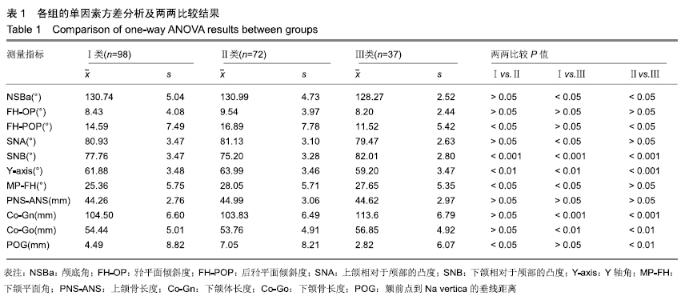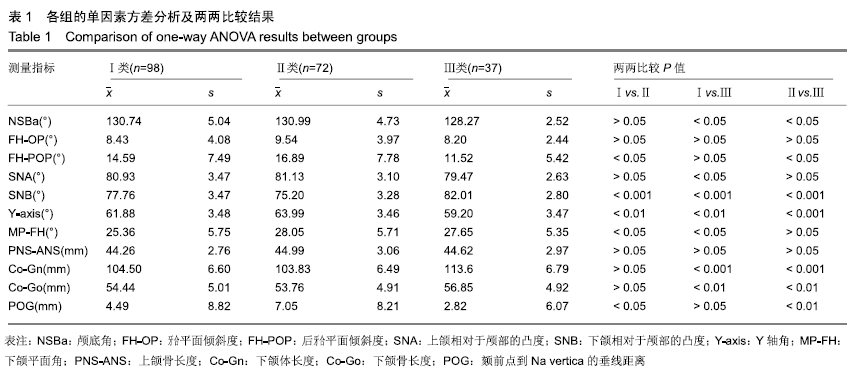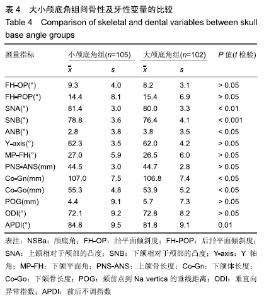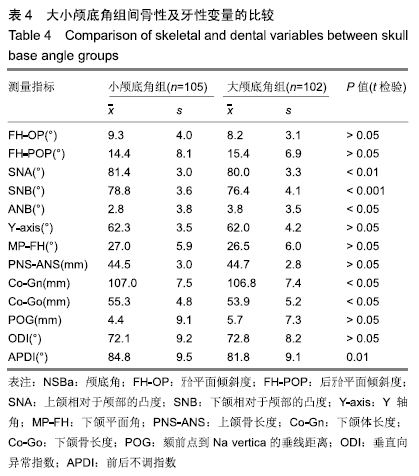Chinese Journal of Tissue Engineering Research ›› 2020, Vol. 24 ›› Issue (11): 1659-1665.doi: 10.3969/j.issn.2095-4344.2487
Previous Articles Next Articles
Influence of cranial base angle and posterior occlusal plane inclination on sagittal dentoskeletal types
Yu Xingyue1, Lü Dongmei1, Tian Shancan1, Yuan Xiaoping2, Cheng Qian2
- 1School of Stomatology, Southwest Medical University, Luzhou 646000, Sichuan Province, China; 2Department of Orthodontics, Hospital of Stomatology, Southwest Medical University, Luzhou 646000, Sichuan Province, China
-
Received:2019-05-20Revised:2019-05-27Accepted:2019-07-15Online:2020-04-18Published:2020-02-21 -
Contact:Cheng Qian, Master, Attending physician, Department of Orthodontics, Hospital of Stomatology, Southwest Medical University, Luzhou 646000, Sichuan Province, China -
About author:Yu Xingyue, Master candidate, Physician, School of Stomatology, Southwest Medical University, Luzhou 646000, Sichuan Province, China -
Supported by:the Youth Foundation of Hospital of Stomatology, Southwest Medical University, No. 201810
CLC Number:
Cite this article
Yu Xingyue, Lü Dongmei, Tian Shancan, Yuan Xiaoping, Cheng Qian. Influence of cranial base angle and posterior occlusal plane inclination on sagittal dentoskeletal types[J]. Chinese Journal of Tissue Engineering Research, 2020, 24(11): 1659-1665.
share this article

2.2 颅底角、牙合平面、后牙牙合平面与测量指标相关性分析结果 NSBa角(颅底角)与FH-OP(牙合平面倾斜度)和FH-POP(后牙牙合平面倾斜度)之间无相关性,FH-OP和FH-POP之间的呈弱相关。NSBa角、FH-OP、FH-POP与ANB角均呈正相关,即说明颅底角越大,牙合平面越陡;后牙牙合平面倾斜度越陡,则ANB角越大,骨面型在矢状向上越可能呈现Ⅱ类关系。FH-OP与SNB角、Y轴角、MP-FH角及POG存在显著性相关关系,提示牙合平面的倾斜度会影响下颌骨的位置。FH-POP和SNB角、Y轴角、MP-FH角度和POG的相关趋势和FH-OP与以上指标的相关趋势类似,但相关性相对较弱。FH-POP和NSBa角与APDI值呈负相关,FH-OP和APDI无相关性。见表2。 "

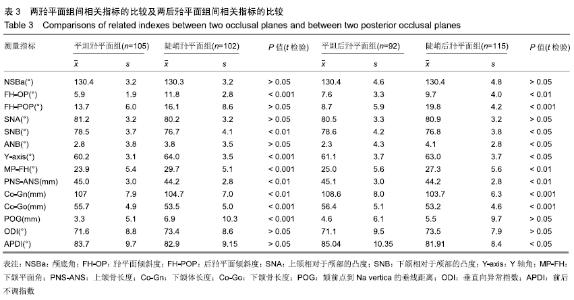
2.3 陡峭和平坦的牙合平面组之间相关指标比较结果 如表3所示,陡峭牙合平面组和平坦牙合平面组相比,PNS-ANS (可示上颌骨的大小),SNB、Y-axis、Co-Gn、Co-Go、POG、MP-FH(可示下颌骨的位置)均存在差异,且差异有显著性意义(P < 0.01)。陡峭后牙合平面组和平坦后牙合平面组比较显示:陡峭FH-POP组的ANB角大于平坦FH-POP组(P < 0.05),但对于APDI值,平坦FH-POP组较陡峭FH-POP组的更大(P < 0.05),但这两者在陡峭FH-OP倾斜组和平坦FH-OP倾斜组之间并未发现差异。这表明与牙合平面倾斜度相比,后牙牙合平面对矢状骨面型的影响更明显。 "
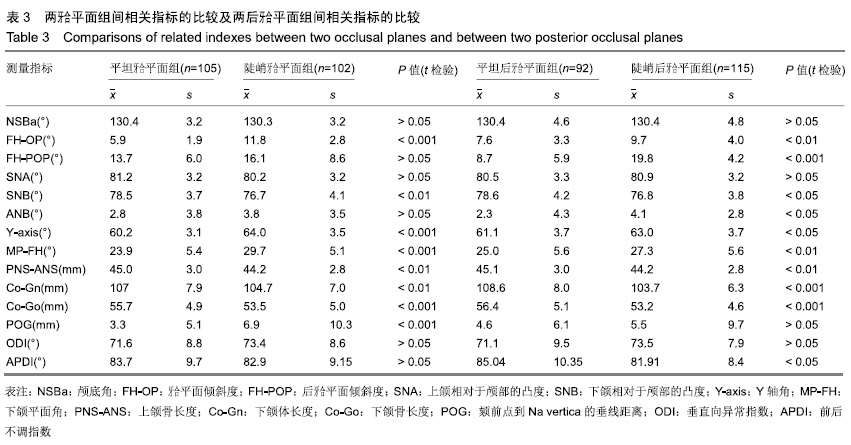

2.5 大小颅底角组和陡峭、平坦牙合平面组交叉成组的比较 对于ANB角度,组间的成对比较示小颅底角-平坦后牙合平面倾斜组(S-F组)与大颅底角度陡峭的后牙牙合平面倾斜组(L-S组)之间的差异有显著性意义(P < 0.001),对于APDI值也发现了类似的情况。另外,小颅底角陡后牙合平面(S-S组)和大颅底角陡后牙合平面组(L-S组)的APDI值相比差异有显著性意义(P < 0.05)。小颅底角陡后牙合平面组与小颅底角平坦后牙合平面组、大颅底角陡后牙合平面组及大颅底角平坦后牙 牙合平面组的APDI和ANB差异无显著性意义,平坦后牙合平面大颅底角组和平坦后牙合平面小颅底角组、陡后牙牙合平面大颅底角组和陡后牙牙合平面小颅底角组的APDI和ANB的差异也无显著性意义。见表5。 "

| [1] 程钎,安舒,黄跃.颅底曲度对矢状骨面型形成影响的初步研究[J].西部医学,2016,28(9):1289-1292. [2] 王岩,于新,刘奕.不同矢状向错(牙合)颅底形态特征的研究[J].临床口腔医学杂志,2012,28(5):271-274. [3] ČELAR A, TAFAJ E, GRAF A. Association of anterior and posterior occlusal planes with different Angle and skeletal classes in permanent dentitions: A lateral cephalometric radiograph study.J Orofac Orthop.2018;79:267-276. [4] DIBBETS JH. Morphological association between the Angle classes.Eur J Orthod. 1996;18(2):111-118. [5] ALMEIDA KCM, RAVELI TB, VIEIRA CIV, et al.Influence of the cranial base flexion on Class I,Ⅱand III malocclusions: a systematic review.Dental Press J Orthod.2017;22(5):56-66. [6] SANGGARNJANAVANICH S, SEKIYA T, NOMURA Y, et al. Cranial-base morphology in adults with skeletal Class III malocclusion.Am J Orthod Dentofacial Orthop.2014;146:82-91. [7] BRATU DC, BĂLAN RA, SZUHANEK CA, et al.Craniofacial morphology in patients with Angle Class II division 2 malocclusion.Rom J Morphol Embryol.2014;55:909-913. [8] SADAO SATO. The dynamic functional anatomy of the craniofacial complex and its relation to the articulations of dentition.The Masticatory Organ.2002. [9] RENFROE EW. A study of the facial patterns associated with class I, class II division 1, class II division 2 malocclusions. Angle Orthod.1948;18:12-15. [10] MENEZES DM.Comparison of craniofacial features of English children with Angle class II division 1 and Angle class I occlusions. J Dent.1974;2:250-254. [11] GUYER EC, ELLIS EE, MCNAMARA JA,et al.Components of class III malocclusion in juveniles and adolescents.Angle Orthod.1986;56:7-30. [12] BATTAGEL JM.The aetiology of class III malocclusion examined by tensor analysis.Br J Orthod.1993;20:283-2963. [13] DHOPATKAR A, BHATIA S, ROCK P.An Investigation Into the Relationship Between the Cranial Base Angle and Malocclusion. Angle Orthod.2002;72:456-446. [14] PETROVIC AG, STUTZMAN J.Control Process in the postnatal growth of the condylar cartilage//MCNAMARA JA Jr, ed. Determinants of mandibular form and growth. Monograph 4. Craniofacial growth series. Center for human growth and development. University of Michigan.Ann Arbor.1975. [15] PERTOVIC AG, STUTZMAN J. The biology of occlusal development. Monograph 6. Cranial growth series. Center for human growth and development.University of Michigan.Ann Arbor.Michigan.1977. [16] KIM JI, AKIMOTO S, SHINJI H,et al.Importance of vertical dimension and cant of occlusal plane in craniofacial development.J Stomat Occ Med.2009;2:114-121. [17] TANAKA EM, SATO S.Longitudinal alteration of the occlusal plane and development of different dentoskeletal frames during growth.Am J Orthod Dentofacial Orthop.2008; 134: 602.e1-602.e11. [18] LAMARQUE S.The importance of occlusal plane control during orthodontic mechanotherapy.Am J Orthod Dentofacial Orthop. 1995;107(5):548-558. [19] PAULO BELTRÃO. Treatment of Class II Deep Overbite with Multiloop Edgewise Arch-Wire (MEAW) Therapy. Principles in Contemporary Orthodontics.2011. [20] MCNAMARA JA JR.A method of cephalometric analysis.// McNamara JA Jr, Ribbens KA, Howe RP(eds). Clinical alteration of the growing face, Monograph 14, Craniofacial Growth Series. Center for Human Growth and Development, University of Michigan, Ann Arbor.1983:81-105. [21] RICKETTS RM.The influence of orthodontic treatment on facial growth and development Angle Orthod. 1960;30: 103-133. [22] DOWNS WB.Variations in facial relationships: their significance in treatment and prognosis.Am J Orthod.1948;34: 812-840. [23] TANAKA EM, SATO S.Longitudinal alteration of the occlusal plane and development of different dentoskeletalframes during growth.Am J Orthod Dentofacial Orthop. 2008;134(5): 602.e1-11; discussion 602-603. [24] RIEDEL RA.The relation of maxillary structures to cranium in malocclusion and in normal occlusion. Angle Orthod.1952;22: 142-145. [25] KIM YH, VIETAS JJ.Anteroposterior dysplasia indicator: an adjunct to cephalometric differential diagnosis.Am J Orthod. 1978;73:619-633. [26] KIM YH. Overbite depth indicator with particular reference to anterior openbite.Am J Orthod.1974;65:586-611. [27] DAHLBERG AG.Statistical methods for medical and biological students.New York:Interscience Publications; 1940. [28] HOUSTON WJ.The analysis of errors in orthodontic measurements.Am J Orthod.1983;83:382-390. [29] 江久汇,纪昌蓉.安氏Ⅱ、Ⅲ类错牙合颅底与颌面形态关系研究[J].北京口腔医学,2001,9(4):166-169. [30] KERR WJ, HIRST D.Craniofacial characteristics of subjects with normal and postnormal occlusions-a longitudinal study.Am J Orthod Dentofacial Orthop.1987;92(3):207-212. [31] SATO S, SAKAI H, SUGISHITA T, et al. Developmental alteration of the form of denture frame in skeletal Class III malocclusion and its significance in orthodontic diagnosis and treatment.Int J MEAW Tech Res Found1.1994;1:33-34 [32] REYES BC, BACETTI T, MCNAMARA JA JR.An estimate of craniofacial growth in class IIII malocclusion. Angle Orthod. 2006;76:577-584. [33] SATO M, MOTOYOSHI M, HIRABAYASHI M, et al.Inclination of the occlusal plane is associated with the direction of the masticatory movement path.Eur J Orthod.2007;29:21-25. [34] PRIEST G, WILSON MG. An evaluation of benchmarks for esthetic orientation of the occlusal plane. J Prosthodont. 2017;26:216-223. [35] BJÖRK A, SKIELLER V.Facial development and tooth eruption. An implant study at the age of puberty.Am J Orthod. 1972;62(4):339-383. [36] BJORK A, SKIELLER V. Postnatal growth and development of the maxillary complex//McNamara JA Jr (ed.) Factors affecting the growth of the midface, Monograph 6, Craniofacial Growth Series. Center for Human Growth and Development.University of Michigan.Ann Arbor.1976:61-99. [37] 龚爱秀,李静,胡芳.乳牙期骨性Ⅱ类与Ⅲ类错牙合颅底形态差异的研究[J].临床口腔医学杂志,2013,29(2):113-115. [38] CORO JC, VELASQUEZ RL, CORO IM, et al.Relationship of maxillary 3-dimensional posterior occlusal plane to mandibular spatial position and morphology. Am J Orthod Dentofacial Orthop.2016;150:140-152. |
| [1] | Liu Yafei, Wang Yalin, Zuo Yanping, Sun Qi, Wei Jing, Zhao Lixia. Structural changes of the temporomandibular joint in adolescents with skeletal Class III malocclusions after maxillary protraction: an X-ray measurement analysis [J]. Chinese Journal of Tissue Engineering Research, 2021, 25(8): 1154-1159. |
| [2] | Fan Jiabing, Zhang Junmei. Morphological measurement and analysis of the mandible in adult females with different vertical skeletal types [J]. Chinese Journal of Tissue Engineering Research, 2021, 25(8): 1177-1183. |
| [3] | Wu Min1, Li Xue1, Gao Jie1, Yang Shuai1, Cai Yizhi2, Wang Mingguo1 . Micro-CT changes and vascular endothelial growth factor expression in reconstructed mandibular condylar cartilage under continuous mandibular advancement in growing and adult rats [J]. Chinese Journal of Tissue Engineering Research, 2019, 23(7): 1001-1006. |
| [4] | Xie Hui1, Qin Bo2, Wang Souxin2, Mo Chaolun2, Zhang Junmei2. Measurement of hard and soft tissues of the zygomaticomaxillary region by multi-planner reconstruction [J]. Chinese Journal of Tissue Engineering Research, 2019, 23(31): 4945-4949. |
| [5] | Jiang Weijie1, 2, Liu Jun2, Liu Changcui3, Zhang Chen1, 2. Alveolar bone change of the maxillary anterior region after retraction in adult patients with class II1 malocclusion using cone-beam CT [J]. Chinese Journal of Tissue Engineering Research, 2019, 23(19): 2986-2990. |
| [6] | Wu Jie1, Wang Chao-ran2, Zhao Wei1, Sun Meng-jiao1, Li Hong-fa1. Characteristics of dental arch and basal bone in permanent dentition Angle Class II malocclusion based on three-dimensional digital models [J]. Chinese Journal of Tissue Engineering Research, 2017, 21(36): 5769-5774. |
| [7] | Liu Yu, Zhang Qi, Li Tian-shu, Fu Gui-yuan, Xu Lin, Yi Long, Wang Jia-ying, Güzelay, He Yuan, Gao Lu. Application of mandibular kinesiography in dental occlusion [J]. Chinese Journal of Tissue Engineering Research, 2016, 20(29): 4341-4348. |
| [8] | Ruan Xiao-hui, Hou Peng, Wu Pei-ling. Correlation of alveolar bone structure and incisor labial inclination in adolescents with skeletal class II malocclusion of Uygur and Han populations in Xinjiang, China [J]. Chinese Journal of Tissue Engineering Research, 2016, 20(24): 3549-3554. |
| [9] | Ding Yu-de, Yang Bin. Application of three-dimensional scanning and measuring techniques in the diagnosis and treatment of mandibular prognathism [J]. Chinese Journal of Tissue Engineering Research, 2016, 20(20): 2992-2999. |
| [10] | Ruan Xiao-hui, Li Liang, Wu Pei-ling . Morphological characteristics of the incisive alveolar bone in adolescents with skeletal class II malocclusion of different vertical facial skeletal types [J]. Chinese Journal of Tissue Engineering Research, 2015, 19(7): 1018-1022. |
| [11] | Li Qing-zhu. 3M self-locking bracket versus straight wire bracket during orthodontic treatment [J]. Chinese Journal of Tissue Engineering Research, 2015, 19(25): 4043-4047. |
| [12] | Li Xiao-guang, Man Da-peng, Qi Wei-feng, Kong Yu. Craniofacial tissue characteristics in adult Angle class II malocclusions: cephalometric X-ray measurement [J]. Chinese Journal of Tissue Engineering Research, 2015, 19(20): 3173-3177. |
| [13] | Wang Jie, Ma Ce, Wang Yu-rong, Chen De-yu. Expression of bone morphogenetic protein-2 and bone morphogenetic protein-4 in Skeletal Class II Malocclusion during growth peak [J]. Chinese Journal of Tissue Engineering Research, 2015, 19(20): 3183-3187. |
| [14] | Jin Zhao-hui, Liu Wen-hui. Biomechanical difference between Twin-Block appliance and straight wire appliance in the early treatment of Class II division 1 malocclusion [J]. Chinese Journal of Tissue Engineering Research, 2015, 19(12): 1842-1845. |
| [15] | Yang Chuan, Zu Qing, Leng Chun-tao, Gulibaha•Maimaitili. Comparison of mandibular length in patients with Class I and Class II skeletal patterns using the cervical vertebrae maturation [J]. Chinese Journal of Tissue Engineering Research, 2014, 18(2): 187-192. |
| Viewed | ||||||
|
Full text |
|
|||||
|
Abstract |
|
|||||
